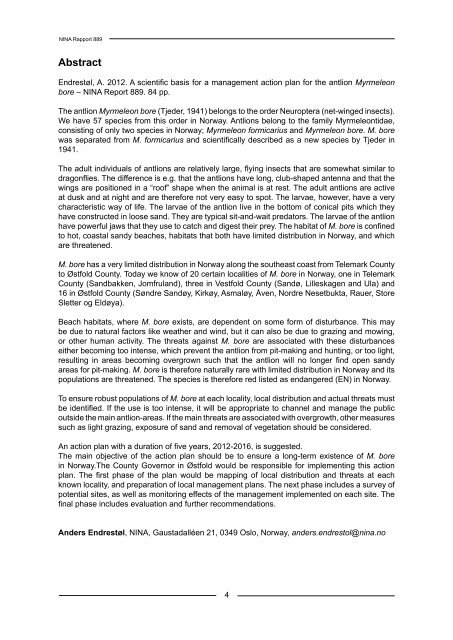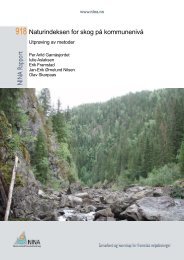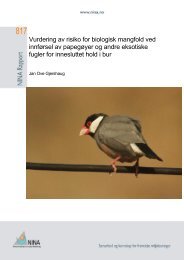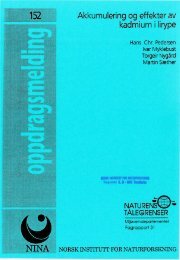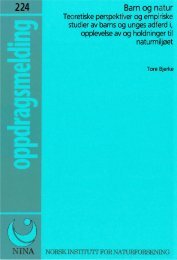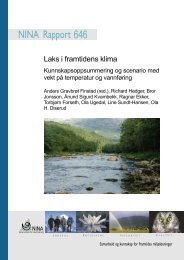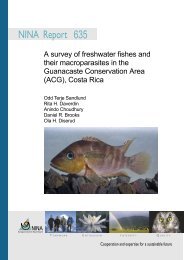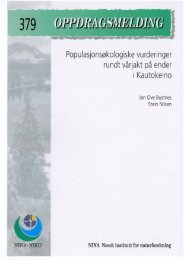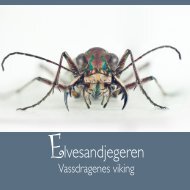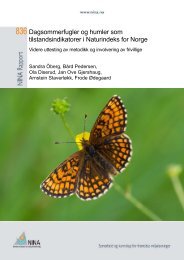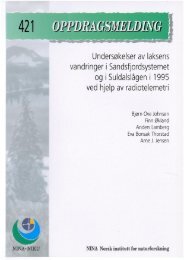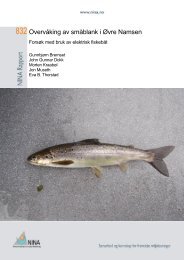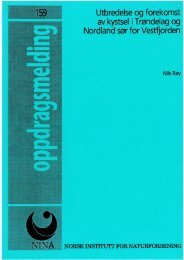Faglig grunnlag for handlingsplan for strandmaurløve ... - NINA
Faglig grunnlag for handlingsplan for strandmaurløve ... - NINA
Faglig grunnlag for handlingsplan for strandmaurløve ... - NINA
Create successful ePaper yourself
Turn your PDF publications into a flip-book with our unique Google optimized e-Paper software.
<strong>NINA</strong> Rapport 889<br />
Abstract<br />
Endrestøl, A. 2012. A scientific basis <strong>for</strong> a management action plan <strong>for</strong> the antlion Myrmeleon<br />
bore – <strong>NINA</strong> Report 889. 84 pp.<br />
The antlion Myrmeleon bore (Tjeder, 1941) belongs to the order Neuroptera (net-winged insects).<br />
We have 57 species from this order in Norway. Antlions belong to the family Myrmeleontidae,<br />
consisting of only two species in Norway; Myrmeleon <strong>for</strong>micarius and Myrmeleon bore. M. bore<br />
was separated from M. <strong>for</strong>micarius and scientifically described as a new species by Tjeder in<br />
1941.<br />
The adult individuals of antlions are relatively large, flying insects that are somewhat similar to<br />
dragonflies. The difference is e.g. that the antlions have long, club-shaped antenna and that the<br />
wings are positioned in a “roof” shape when the animal is at rest. The adult antlions are active<br />
at dusk and at night and are there<strong>for</strong>e not very easy to spot. The larvae, however, have a very<br />
characteristic way of life. The larvae of the antlion live in the bottom of conical pits which they<br />
have constructed in loose sand. They are typical sit-and-wait predators. The larvae of the antlion<br />
have powerful jaws that they use to catch and digest their prey. The habitat of M. bore is confined<br />
to hot, coastal sandy beaches, habitats that both have limited distribution in Norway, and which<br />
are threatened.<br />
M. bore has a very limited distribution in Norway along the southeast coast from Telemark County<br />
to Østfold County. Today we know of 20 certain localities of M. bore in Norway, one in Telemark<br />
County (Sandbakken, Jomfruland), three in Vestfold County (Sandø, Lilleskagen and Ula) and<br />
16 in Østfold County (Søndre Sandøy, Kirkøy, Asmaløy, Åven, Nordre Nesetbukta, Rauer, Store<br />
Sletter og Eldøya).<br />
Beach habitats, where M. bore exists, are dependent on some <strong>for</strong>m of disturbance. This may<br />
be due to natural factors like weather and wind, but it can also be due to grazing and mowing,<br />
or other human activity. The threats against M. bore are associated with these disturbances<br />
either becoming too intense, which prevent the antlion from pit-making and hunting, or too light,<br />
resulting in areas becoming overgrown such that the antlion will no longer find open sandy<br />
areas <strong>for</strong> pit-making. M. bore is there<strong>for</strong>e naturally rare with limited distribution in Norway and its<br />
populations are threatened. The species is there<strong>for</strong>e red listed as endangered (EN) in Norway.<br />
To ensure robust populations of M. bore at each locality, local distribution and actual threats must<br />
be identified. If the use is too intense, it will be appropriate to channel and manage the public<br />
outside the main antlion-areas. If the main threats are associated with overgrowth, other measures<br />
such as light grazing, exposure of sand and removal of vegetation should be considered.<br />
An action plan with a duration of five years, 2012-2016, is suggested.<br />
The main objective of the action plan should be to ensure a long-term existence of M. bore<br />
in Norway.The County Governor in Østfold would be responsible <strong>for</strong> implementing this action<br />
plan. The first phase of the plan would be mapping of local distribution and threats at each<br />
known locality, and preparation of local management plans. The next phase includes a survey of<br />
potential sites, as well as monitoring effects of the management implemented on each site. The<br />
final phase includes evaluation and further recommendations.<br />
Anders Endrestøl, <strong>NINA</strong>, Gaustadalléen 21, 0349 Oslo, Norway, anders.endrestol@nina.no<br />
4


